Monday, 21 October 2019
Friday, 4 October 2019
SQL CREATE INDEX Statement
SQL CREATE INDEX Statement
The CREATE INDEX statement is used to create indexes in tables.
Indexes are used to retrieve data from the database very fast. The users cannot see the indexes, they are just used to speed up searches/queries.
Note: Updating a table with indexes takes more time than updating a table without (because the indexes also need an update). So, only create indexes on columns that will be frequently searched against.
CREATE INDEX Syntax
Creates an index on a table. Duplicate values are allowed:
CREATE INDEX index_name
ON table_name (column1, column2, ...);
CREATE UNIQUE INDEX Syntax
Creates a unique index on a table. Duplicate values are not allowed:
CREATE UNIQUE INDEX index_name
ON table_name (column1, column2, ...);
Note: The syntax for creating indexes varies among different databases. Therefore: Check the syntax for creating indexes in your database.
CREATE INDEX Example
The SQL statement below creates an index named "idx_lastname" on the "LastName" column in the "Persons" table:
CREATE INDEX idx_lastname
ON Persons (LastName);
If you want to create an index on a combination of columns, you can list the column names within the parentheses, separated by commas:
CREATE INDEX idx_pname
ON Persons (LastName, FirstName);
DROP INDEX Statement
The DROP INDEX statement is used to delete an index in a table.
MS Access:
DROP INDEX index_name ON table_name;
SQL Server:
DROP INDEX table_name.index_name;
DB2/Oracle:
DROP INDEX index_name;
MySQL:
ALTER TABLE table_nameDROP INDEX index_name;
SQL Injection
Overview
A SQL injection attack consists of insertion or "injection" of a SQL query via the input data from the client to the application. A successful SQL injection exploit can read sensitive data from the database, modify database data (Insert/Update/Delete), execute administration operations on the database (such as shutdown the DBMS), recover the content of a given file present on the DBMS file system and in some cases issue commands to the operating system. SQL injection attacks are a type of injection attack, in which SQL commands are injected into data-plane input in order to effect the execution of predefined SQL commands.
Threat Modeling
- SQL injection attacks allow attackers to spoof identity, tamper with existing data, cause repudiation issues such as voiding transactions or changing balances, allow the complete disclosure of all data on the system, destroy the data or make it otherwise unavailable, and become administrators of the database server.
- SQL Injection is very common with PHP and ASP applications due to the prevalence of older functional interfaces. Due to the nature of programmatic interfaces available, J2EE and ASP.NET applications are less likely to have easily exploited SQL injections.
- The severity of SQL Injection attacks is limited by the attacker’s skill and imagination, and to a lesser extent, defense in depth countermeasures, such as low privilege connections to the database server and so on. In general, consider SQL Injection a high impact severity.
Related Security Activities
How to Avoid SQL Injection Vulnerabilities
See the OWASP SQL Injection Prevention Cheat Sheet.
See the OWASP Query Parameterization Cheat Sheet.
See the OWASP Guide article on how to Avoid SQL Injection Vulnerabilities.
See the OWASP Query Parameterization Cheat Sheet.
See the OWASP Guide article on how to Avoid SQL Injection Vulnerabilities.
How to Review Code for SQL Injection Vulnerabilities
See the OWASP Code Review Guide article on how to Review Code for SQL Injection Vulnerabilities.
How to Test for SQL Injection Vulnerabilities
See the OWASP Testing Guide article on how to Test for SQL Injection Vulnerabilities.
How to Bypass Web Application Firewalls with SQLi
See the OWASP Article on using SQL Injection to bypass a WAF
Description
SQL injection errors occur when:
- Data enters a program from an untrusted source.
- The data used to dynamically construct a SQL query
The main consequences are:
- Confidentiality: Since SQL databases generally hold sensitive data, loss of confidentiality is a frequent problem with SQL Injection vulnerabilities.
- Authentication: If poor SQL commands are used to check user names and passwords, it may be possible to connect to a system as another user with no previous knowledge of the password.
- Authorization: If authorization information is held in a SQL database, it may be possible to change this information through the successful exploitation of a SQL Injection vulnerability.
- Integrity: Just as it may be possible to read sensitive information, it is also possible to make changes or even delete this information with a SQL Injection attack.
Risk Factors
The platform affected can be:
- Language: SQL
- Platform: Any (requires interaction with a SQL database)
SQL Injection has become a common issue with database-driven web sites. The flaw is easily detected, and easily exploited, and as such, any site or software package with even a minimal user base is likely to be subject to an attempted attack of this kind.
Essentially, the attack is accomplished by placing a meta character into data input to then place SQL commands in the control plane, which did not exist there before. This flaw depends on the fact that SQL makes no real distinction between the control and data planes.
Examples
Example 1
In SQL:
select id, firstname, lastname from authors
If one provided:
Firstname: evil'ex
Lastname: Newman
the query string becomes:
select id, firstname, lastname from authors where forename = 'evil'ex' and surname ='newman'
which the database attempts to run as:
Incorrect syntax near il' as the database tried to execute evil.
A safe version of the above SQL statement could be coded in Java as:
String firstname = req.getParameter("firstname");
String lastname = req.getParameter("lastname");
// FIXME: do your own validation to detect attacks
String query = "SELECT id, firstname, lastname FROM authors WHERE forename = ? and surname = ?";
PreparedStatement pstmt = connection.prepareStatement( query );
pstmt.setString( 1, firstname );
pstmt.setString( 2, lastname );
try
{
ResultSet results = pstmt.execute( );
}
Example 2
The following C# code dynamically constructs and executes a SQL query that searches for items matching a specified name. The query restricts the items displayed to those where owner matches the user name of the currently-authenticated user.
...
string userName = ctx.getAuthenticatedUserName();
string query = "SELECT * FROM items WHERE owner = "'"
+ userName + "' AND itemname = '"
+ ItemName.Text + "'";
sda = new SqlDataAdapter(query, conn);
DataTable dt = new DataTable();
sda.Fill(dt);
...
The query that this code intends to execute follows:
SELECT * FROM items
WHERE owner =
AND itemname = ;
However, because the query is constructed dynamically by concatenating a constant base query string and a user input string, the query only behaves correctly if itemName does not contain a single-quote character. If an attacker with the user name wiley enters the string "name' OR 'a'='a" for itemName, then the query becomes the following:
SELECT * FROM items
WHERE owner = 'wiley'
AND itemname = 'name' OR 'a'='a';
The addition of the OR 'a'='a' condition causes the where clause to always evaluate to true, so the query becomes logically equivalent to the much simpler query:
SELECT * FROM items;
This simplification of the query allows the attacker to bypass the requirement that the query only return items owned by the authenticated user; the query now returns all entries stored in the items table, regardless of their specified owner.
Example 3
This example examines the effects of a different malicious value passed to the query constructed and executed in Example 1. If an attacker with the user name hacker enters the string "name'); DELETE FROM items; --" for itemName, then the query becomes the following two queries:
SELECT * FROM items
WHERE owner = 'hacker'
AND itemname = 'name';
DELETE FROM items;
--'
Many database servers, including Microsoft® SQL Server 2000, allow multiple SQL statements separated by semicolons to be executed at once. While this attack string results in an error in Oracle and other database servers that do not allow the batch-execution of statements separated by semicolons, in databases that do allow batch execution, this type of attack allows the attacker to execute arbitrary commands against the database.
Notice the trailing pair of hyphens (--), which specifies to most database servers that the remainder of the statement is to be treated as a comment and not executed. In this case the comment character serves to remove the trailing single-quote left over from the modified query. In a database where comments are not allowed to be used in this way, the general attack could still be made effective using a trick similar to the one shown in Example 1. If an attacker enters the string "name'); DELETE FROM items; SELECT * FROM items WHERE 'a'='a", the following three valid statements will be created:
SELECT * FROM items
WHERE owner = 'hacker'
AND itemname = 'name';
DELETE FROM items;
SELECT * FROM items WHERE 'a'='a';
One traditional approach to preventing SQL injection attacks is to handle them as an input validation problem and either accept only characters from a whitelist of safe values or identify and escape a blacklist of potentially malicious values. Whitelisting can be a very effective means of enforcing strict input validation rules, but parameterized SQL statements require less maintenance and can offer more guarantees with respect to security. As is almost always the case, blacklisting is riddled with loopholes that make it ineffective at preventing SQL injection attacks. For example, attackers can:
- Target fields that are not quoted
- Find ways to bypass the need for certain escaped meta-characters
- Use stored procedures to hide the injected meta-characters
Manually escaping characters in input to SQL queries can help, but it will not make your application secure from SQL injection attacks.
Another solution commonly proposed for dealing with SQL injection attacks is to use stored procedures. Although stored procedures prevent some types of SQL injection attacks, they fail to protect against many others. For example, the following PL/SQL procedure is vulnerable to the same SQL injection attack shown in the first example.
procedure get_item (
itm_cv IN OUT ItmCurTyp,
usr in varchar2,
itm in varchar2)
is
open itm_cv for ' SELECT * FROM items WHERE ' ||
'owner = '''|| usr ||
' AND itemname = ''' || itm || '''';
end get_item;
Stored procedures typically help prevent SQL injection attacks by limiting the types of statements that can be passed to their parameters. However, there are many ways around the limitations and many interesting statements that can still be passed to stored procedures. Again, stored procedures can prevent some exploits, but they will not make your application secure against SQL injection attacks.
Related Threat Agents
Related Attacks
- Injection Risk (OWASP Top Ten 2013)
- SQL Injection Bypassing WAF
- Blind SQL Injection
- Code Injection
- Double Encoding
- Interpreter_Injection#ORM_Injection
Related Vulnerabilities
Related Controls
References
- SQL Injection Knowledge Base - A reference guide for MySQL, MSSQL and Oracle SQL Injection attacks.
- GreenSQL Open Source SQL Injection Filter - An Open Source database firewall used to protect databases from SQL injection attacks.
- An Introduction to SQL Injection Attacks for Oracle Developers - This also includes recommended defenses.
- OWASP SQLiX Project - An SQL Injection Scanner.
- Pangolin - Closed source SQL Injection Scanner.
Ethical Hacking - Wireless Hacking
A wireless network is a set of two or more devices connected with each other via radio waves within a limited space range. The devices in a wireless network have the freedom to be in motion, but be in connection with the network and share data with other devices in the network. One of the most crucial point that they are so spread is that their installation cost is very cheap and fast than the wire networks.
Wireless networks are widely used and it is quite easy to set them up. They use IEEE 802.11 standards. A wireless router is the most important device in a wireless network that connects the users with the Internet.
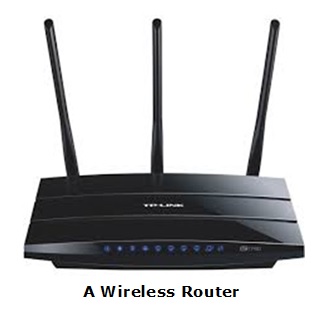
In a wireless network, we have Access Points which are extensions of wireless ranges that behave as logical switches.
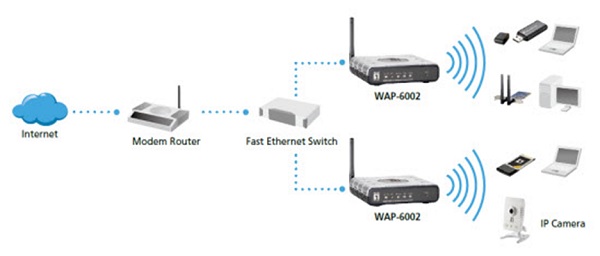
Although wireless networks offer great flexibility, they have their security problems. A hacker can sniff the network packets without having to be in the same building where the network is located. As wireless networks communicate through radio waves, a hacker can easily sniff the network from a nearby location.
Most attackers use network sniffing to find the SSID and hack a wireless network. When our wireless cards are converted in sniffing modes, they are called monitor mode.
Kismet
Kismet is a powerful tool for wireless sniffing that is found in Kali distribution. It can also be downloaded from its official webpage − https://www.kismetwireless.net/index.shtml
Let’s see how it works. First of all, open a terminal and type kismet. Start the Kismet Server and click Yes, as shown in the following screenshot.

As shown here, click the Start button.
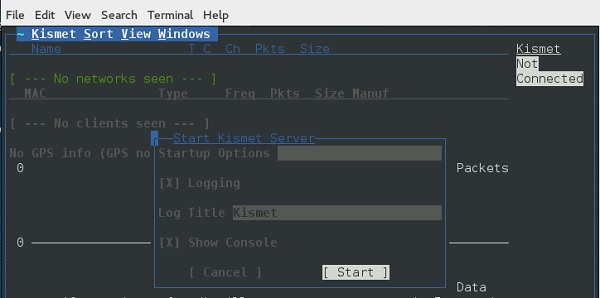
Now, Kismet will start to capture data. The following screenshot shows how it would appear −
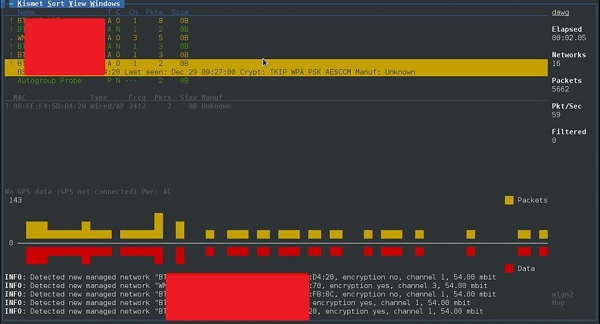
NetStumbler
NetStumbler is another tool for wireless hacking that is primarily meant for Windows systems. It can be downloaded from http://www.stumbler.net/
It is quite easy to use NetStumbler on your system. You just have to click the Scanning button and wait for the result, as shown in the following screenshot.

It should display a screenshot as follows −
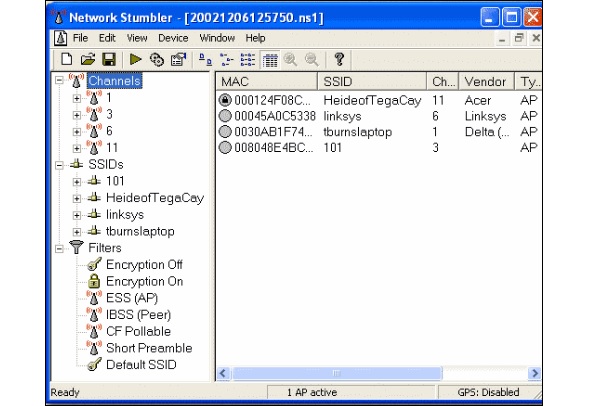
It is important to note that your card should support monitoring mode, otherwise you will fail to monitor.
Wired Equivalent Privacy
Wired Equivalent Privacy (WEP) is a security protocol that was invented to secure wireless networks and keep them private. It utilizes encryption at the data link layer which forbids unauthorized access to the network.
The key is used to encrypt the packets before transmission begins. An integrity check mechanism checks that the packets are not altered after transmission.
Note that WEP is not entirely immune to security problems. It suffers from the following issues −
- CRC32 is not sufficient to ensure complete cryptographic integrity of a packet.
- It is vulnerable to dictionary attacks.
- WEP is vulnerable to Denial of Services attacks too.
WEPcrack
WEPcrack is a popular tool to crack WEP passwords. It can be downloaded from − https://sourceforge.net/projects/wepcrack/
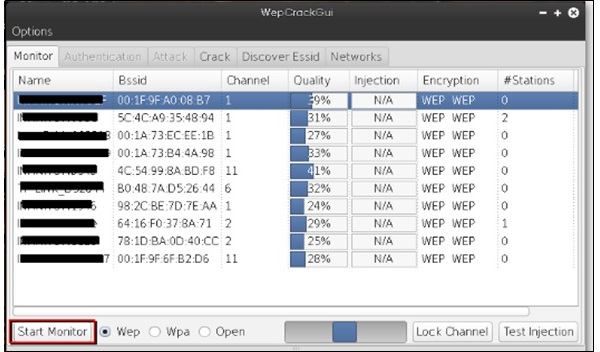
Aircrack-ng
Aircrak-ng is another popular tool for cracking WEP passwords. It can be found in the Kali distribution of Linux.
The following screenshot shows how we have sniffed a wireless network and collected packets and created a file RHAWEP-01.cap. Then we run it with aircrack-ng to decrypt the cypher.
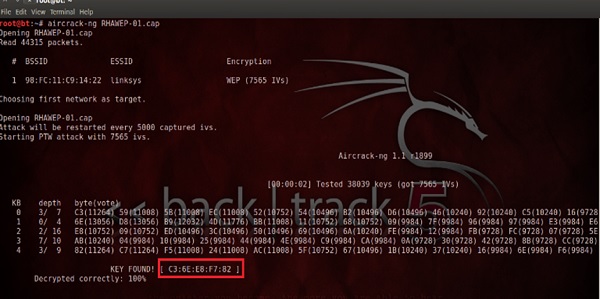
Wireless DoS Attacks
In a wireless environment, an attacker can attack a network from a distance and therefore, it is sometimes difficult to collect evidences against the attacker.
The first type of DoS is Physical Attack. This type of attack is very basic and it is in the base of radio interferences which can be created even from cordless phones that operate in 2.4 GHz range.
Another type is Network DoS Attack. As the Wireless Access Point creates a shared medium, it offers the possibility to flood the traffic of this medium toward the AP which will make its processing more slow toward the clients that attempt to connect. Such attacks can be created just by a ping flood DoS attack.
Pyloris is a popular DoS tool that you can download from − https://sourceforge.net/projects/pyloris/
Low Orbit Ion Cannon (LOIC) is another popular tool for DoS attacks.
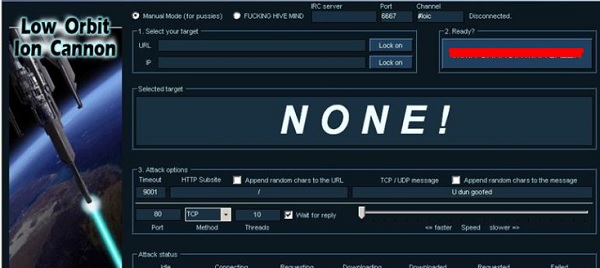
Quick Tips
To secure a wireless network, you should keep the following points in mind −
- Change the SSID and the network password regularly.
- Change the default password of access points.
- Don’t use WEP encryption.
- Turn off guest networking.
- Update the firmware of your wireless device.
Ethical Hacking - DDOS Attacks
A Distributed Denial of Service (DDoS) attack is an attempt to make an online service or a website unavailable by overloading it with huge floods of traffic generated from multiple sources.
Unlike a Denial of Service (DoS) attack, in which one computer and one Internet connection is used to flood a targeted resource with packets, a DDoS attack uses many computers and many Internet connections, often distributed globally in what is referred to as a botnet.
A large scale volumetric DDoS attack can generate a traffic measured in tens of Gigabits (and even hundreds of Gigabits) per second. We are sure your normal network will not be able to handle such traffic.
What are Botnets?
Attackers build a network of hacked machines which are known as botnets, by spreading malicious piece of code through emails, websites, and social media. Once these computers are infected, they can be controlled remotely, without their owners' knowledge, and used like an army to launch an attack against any target.
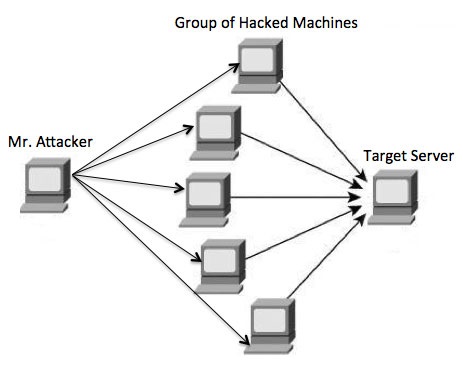
A DDoS flood can be generated in multiple ways. For example −
- Botnets can be used for sending more number of connection requests than a server can handle at a time.
- Attackers can have computers send a victim resource huge amounts of random data to use up the target's bandwidth.
Due to the distributed nature of these machines, they can be used to generate distributed high traffic which may be difficult to handle. It finally results in a complete blockage of a service.
Types of DDoS Attacks
DDoS attacks can be broadly categorized into three categories −
- Volume-based Attacks
- Protocol Attacks
- Application Layer Attacks
Volume-Based Attacks
Volume-based attacks include TCP floods, UDP floods, ICMP floods, and other spoofedpacket floods. These are also called Layer 3 & 4 Attacks. Here, an attacker tries to saturate the bandwidth of the target site. The attack magnitude is measured in Bits per Second (bps).
- UDP Flood − A UDP flood is used to flood random ports on a remote host with numerous UDP packets, more specifically port number 53. Specialized firewalls can be used to filter out or block malicious UDP packets.
- ICMP Flood − This is similar to UDP flood and used to flood a remote host with numerous ICMP Echo Requests. This type of attack can consume both outgoing and incoming bandwidth and a high volume of ping requests will result in overall system slowdown.
- HTTP Flood − The attacker sends HTTP GET and POST requests to a targeted web server in a large volume which cannot be handled by the server and leads to denial of additional connections from legitimate clients.
- Amplification Attack − The attacker makes a request that generates a large response which includes DNS requests for large TXT records and HTTP GET requests for large files like images, PDFs, or any other data files.
Protocol Attacks
Protocol attacks include SYN floods, Ping of Death, fragmented packet attacks, Smurf DDoS, etc. This type of attack consumes actual server resources and other resources like firewalls and load balancers. The attack magnitude is measured in Packets per Second.
- DNS Flood − DNS floods are used for attacking both the infrastructure and a DNS application to overwhelm a target system and consume all its available network bandwidth.
- SYN Flood − The attacker sends TCP connection requests faster than the targeted machine can process them, causing network saturation. Administrators can tweak TCP stacks to mitigate the effect of SYN floods. To reduce the effect of SYN floods, you can reduce the timeout until a stack frees memory allocated to a connection, or selectively dropping incoming connections using a firewall or iptables.
- Ping of Death − The attacker sends malformed or oversized packets using a simple ping command. IP allows sending 65,535 bytes packets but sending a ping packet larger than 65,535 bytes violates the Internet Protocol and could cause memory overflow on the target system and finally crash the system. To avoid Ping of Death attacks and its variants, many sites block ICMP ping messages altogether at their firewalls.
Application Layer Attacks
Application Layer Attacks include Slowloris, Zero-day DDoS attacks, DDoS attacks that target Apache, Windows or OpenBSD vulnerabilities and more. Here the goal is to crash the web server. The attack magnitude is measured in Requests per Second.
- Application Attack − This is also called Layer 7 Attack, where the attacker makes excessive log-in, database-lookup, or search requests to overload the application. It is really difficult to detect Layer 7 attacks because they resemble legitimate website traffic.
- Slowloris − The attacker sends huge number of HTTP headers to a targeted web server, but never completes a request. The targeted server keeps each of these false connections open and eventually overflows the maximum concurrent connection pool, and leads to denial of additional connections from legitimate clients.
- NTP Amplification − The attacker exploits publically-accessible Network Time Protocol (NTP) servers to overwhelm the targeted server with User Datagram Protocol (UDP) traffic.
- Zero-day DDoS Attacks − A zero-day vulnerability is a system or application flaw previously unknown to the vendor, and has not been fixed or patched. These are new type of attacks coming into existence day by day, for example, exploiting vulnerabilities for which no patch has yet been released.
How to Fix a DDoS Attack
There are quite a few DDoS protection options which you can apply depending on the type of DDoS attack.
Your DDoS protection starts from identifying and closing all the possible OS and application level vulnerabilities in your system, closing all the possible ports, removing unnecessary access from the system and hiding your server behind a proxy or CDN system.
If you see a low magnitude of the DDoS, then you can find many firewall-based solutions which can help you in filtering out DDoS based traffic. But if you have high volume of DDoS attack like in gigabits or even more, then you should take the help of a DDoS protection service provider that offers a more holistic, proactive and genuine approach.
You must be careful while approaching and selecting a DDoS protection service provider. There are number of service providers who want to take advantage of your situation. If you inform them that you are under DDoS attack, then they will start offering you a variety of services at unreasonably high costs.
We can suggest you a simple and working solution which starts with a search for a good DNS solution provider who is flexible enough to configure A and CNAME records for your website. Second, you will need a good CDN provider that can handle big DDoS traffic and provide you DDoS protection service as a part of their CDN package.
Assume your server IP address is AAA.BBB.CCC.DDD. Then you should do the following DNS configuration −
- Create a A Record in DNS zone file as shown below with a DNS identifier, for example, ARECORDID and keep it secret from the outside world.
- Now ask your CDN provider to link the created DNS identifier with a URL, something like cdn.someotherid.domain.com.
- You will use the CDN URL cdn.someotherid.domain.com to create two CNAME records, the first one to point to www and the second record to point to @ as shown below.
You can take the help from your system administrator to understand these points and configure your DNS and CDN appropriately. Finally, you will have the following configuration at your DNS.
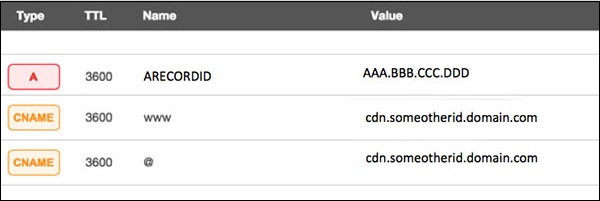
Now, let the CDN provider handle all type of DDoS attacks and your system will remain safe. But here the condition is that you should not disclose your system's IP address or A record identifier to anyone; else direct attacks will start again.
Quick Fix
DDoS attacks have become more common than ever before, and unfortunately, there is no quick fix for this problem. However, if your system is under a DDoS attack, then don’t panic and start looking into the matter step by step.
Ethical Hacking - Process
Like all good projects, ethical hacking too has a set of distinct phases. It helps hackers to make a structured ethical hacking attack.
Different security training manuals explain the process of ethical hacking in different ways, but for me as a Certified Ethical Hacker, the entire process can be categorized into the following six phases.
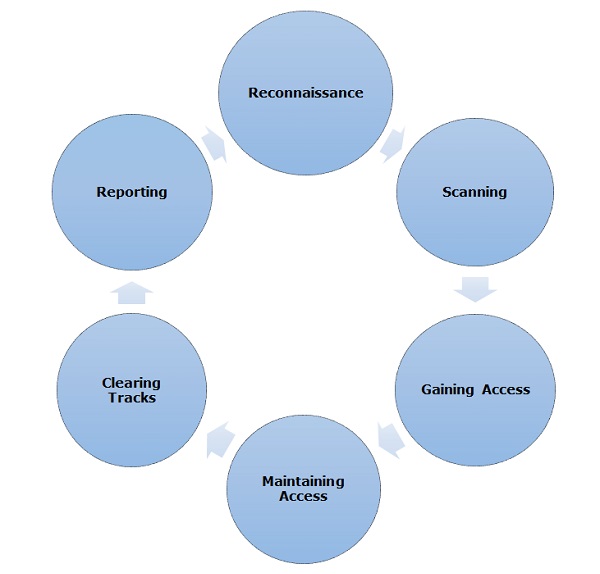
Reconnaissance
Reconnaissance is the phase where the attacker gathers information about a target using active or passive means. The tools that are widely used in this process are NMAP, Hping, Maltego, and Google Dorks.
Scanning
In this process, the attacker begins to actively probe a target machine or network for vulnerabilities that can be exploited. The tools used in this process are Nessus, Nexpose, and NMAP.
Gaining Access
In this process, the vulnerability is located and you attempt to exploit it in order to enter into the system. The primary tool that is used in this process is Metasploit.
Maintaining Access
It is the process where the hacker has already gained access into a system. After gaining access, the hacker installs some backdoors in order to enter into the system when he needs access in this owned system in future. Metasploit is the preferred tool in this process.
Clearing Tracks
This process is actually an unethical activity. It has to do with the deletion of logs of all the activities that take place during the hacking process.
Reporting
Reporting is the last step of finishing the ethical hacking process. Here the Ethical Hacker compiles a report with his findings and the job that was done such as the tools used, the success rate, vulnerabilities found, and the exploit processes.
Quick Tip
The processes are not standard. You can adopt a set of different processes and tools according to your techniques that you are comfortable with. The process is of least significance as long as you are able to get the desired results.
Subscribe to:
Comments (Atom)
-
Hi All This is my first po st on blogspot. Please comeback soon while I update my blog.